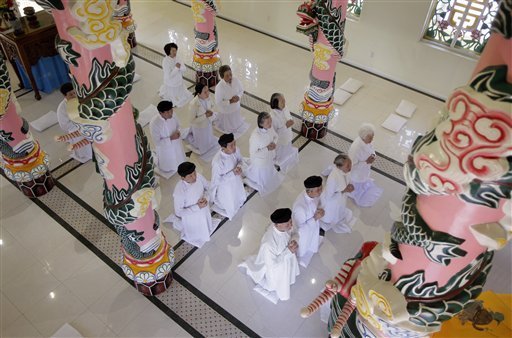
Cao Dai followers pray during a weekly worship service at at Cao Dai Temple of California in Garden Grove, Calif., Sunday, Jan. 31, 2010.
As darkness fell on a recent night, Duc Le donned a long white tunic and black cap, slipped off his shoes and joined other aging Vietnamese American to honor the new moon with the chanted prayers and offerings that mark the Vietnamese religion of Cao Dai.
As Le worshipped, his 25-year-old son stood nearby in sweat pants and chatted with his young bride before slipping away to study for his mid-term exams. The college senior said he visits the temple to teach martial arts more often than to worship and struggles to observe the elaborate rituals of his elders\' faith.
"Usually I don\'t get too involved. I think it\'s the language barrier," said Thuan Le, who finds the higher-level Vietnamese used in Cao Dai prayers difficult to understand. "I definitely see it as a hindrance with all the ceremonies. You have to follow all these procedures to get to the truth of it and that\'s really hard."
Le\'s ambivalence is echoed by many young Vietnamese and marks a turning point for the thousands of people who brought their religion with them to the U.S. and have nurtured it for decades in their adopted homeland.
Now, as the original followers age, Cao Dai\'s most learned scholars in the U.S. are scrambling to build interest among their children and grandchildren while trying to widen the faith\'s appeal to gain new, non-Vietnamese worshippers as well.
But Cao Dai\'s unusual history and a colorful blending of beliefs that earned its most prominent temple in Vietnam the nickname "Walt Disney fantasia of the East" could make that a challenge.
The faith, born in 1926 out of a series of spirit seances, is monotheistic but incorporates elements of the oldest and most established religions in its complex DNA. It took root in French Indochina, in part as a way for the country\'s intellectual elite to reconcile the Christian beliefs of their colonial rulers and ancient Eastern traditions, said Janet Hoskins, an anthropology professor and Cao Dai expert at the University of Southern California.
Practitioners today believe the founders of the world\'s major religions are all messengers of the same God and point to similar teachings on peace and love in all religions. As a result, the faithful pay homage to a cornucopia of religious and philosophical figures, including Jesus, Moses, Muhammad, Lao Tzu, Buddha and Confucius.
Among their saints is the French author Victor Hugo, who is believed to have spoken to spirit mediums from beyond the grave. Hugo\'s image, along with the French slogan "Liberty, Equality and Brotherhood," appears at the front of many Cao Dai temples along with the Chinese revolutionary Sun Yat-sen and the Vietnamese sage Khiem Binh Nguyen.
Practitioners also believe Joan of Arc guided the first Cao Dai disciples in their seances and is one of nine female fairies associated with the Mother Goddess.
Five levels of carved and brightly painted figures depicting Cao Dai\'s saints, prophets and immortals sit above the altar in its temples, where worshippers also burn incense and place tea, wine, fruit and flowers to represent the different aspects of being.
The faith\'s complex history and its emphasis on ritual and hierarchy make it difficult for young people to embrace, even without a language barrier, said Hum Dac Bui, a Cao Dai scholar, author and retired surgeon who lives in Redlands.
Southern California, one of the largest Cao Dai hubs in the U.S., boasts a dozen temples and about 10,000 worshippers, Hoskins said, but even here the elders worry the religion could fade away with time. Cao Dai temples in Vietnam attract thousands and have become tourist draws.
"When the older generation dies, we will not have leaders," said Bui, who meditates four times a day. "There are a lot of youths who come to the temple and they don\'t understand a single word. They don\'t even understand the prayers. That is my worry."
To counter that, the 67-year-old Bui and other Cao Dai scholars have been working hard to translate its scriptures into English and write books that explain the worship and include translations of the faith\'s most critical prayers.
This year, community leaders spent $700,000 to buy a large building in Anaheim and are working nights and weekends to transform it into a Cao Dai cultural center. The center will have a Vietnamese language school, a temple and community outreach programs such as a homeless mission, martial arts, after-school tutoring and interfaith and holistic health classes they hope will draw in non-Vietnamese converts as well.
The center complements an ornate and colorful temple that opened two years ago in nearby Garden Grove - the first U.S. temple built in the traditional Vietnamese style.
At a language class at the new cultural center, about a dozen children studied the Vietnamese alphabet and sang songs on a recent weekend afternoon as their parents worked to renovate the rest of the two-story building.
In Cao Dai, children must reaffirm their religion when they turn 18 through an oath. Bui and others hope the language sessions and Sunday classes will steer them in the right direction.
"We have to train them. Having these Vietnamese classes here will definitely help with that," said Kim Dang, who is also teaching her 9-year-old daughter to meditate. "Now, they\'ll say, \'I\'m not just American, but I\'m Vietnamese born in America.\' That will help them understand the culture - and eventually the religion."
Dang herself recently reconnected with her parents\' faith after losing her sales job in the aerospace industry. She read a stack of books on Cao Dai\'s history that her father had given her years ago and was struck by its message of peace and harmony.
She now meditates regularly and wears a golden Cao Dai pendant that depicts a left eye with rays radiating from it - the "divine eye," a symbol of God. Her life, she said, has a new purpose now.
"I\'m seeing it now and reading the history books now for the first time. I didn\'t know, but our ancestors knew," said Dang, 42, touching her necklace. "I need to reach out, I need to help out. I feel I\'m ready now."
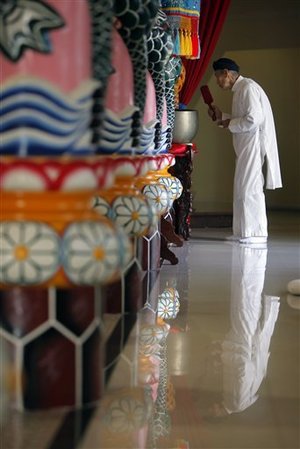
Cao Dai follower Kim Vo hits the gong during a weekly worship service at Cao Dai Temple of California in Garden Grove, Calif.
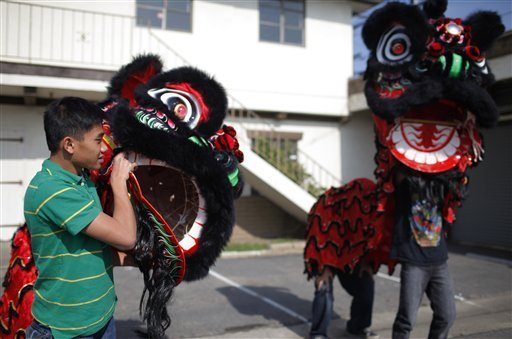
Le Huynh, left, rehearses for a Lunar New Year parade at a Cao Dai education center in Anaheim, Calif.
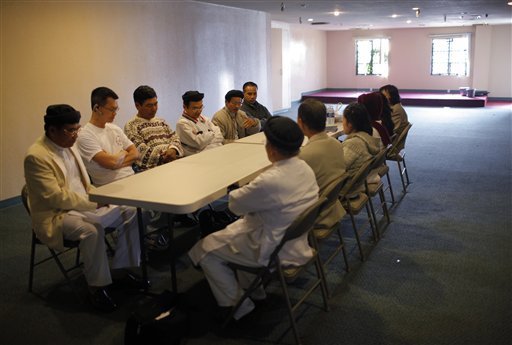
Elderly Cao Dai followers sit around the table during a meeting in an empty hall at a Cao Dai education center they recently purchased in Anaheim, Calif.
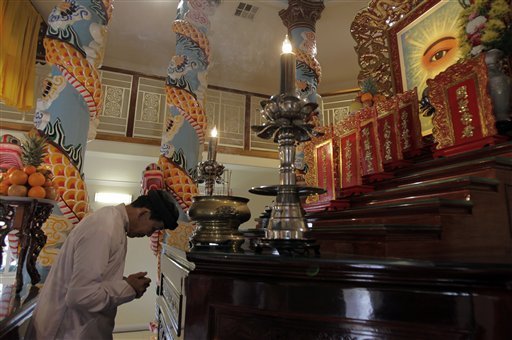
Cao Dai follower Tuoi Nguyen prays during a weekly worship service at Cao Dai Temple of California in Garden Grove, Calif.

Kately Vo, center, plays handball with her friends after a weekly worship service at Cao Dai Temple of California in Garden Grove, Calif.

Leave your comment on this story